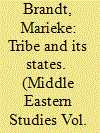|
|
|
Sort Order |
|
|
|
Items / Page
|
|
|
|
|
|
|
| Srl | Item |
| 1 |
ID:
164912


|
|
|
|
|
| Summary/Abstract |
Across the Middle East, tribes and states have entered into different relationships. In many countries, tribes were confronted with massive attempts at interference by their respective states. The northern Yemeni Republic, in contrast, remained a weak state with little coercive instruments at its disposal. Its rule was rather based on indirect means: the politics of patronage, the politicization of development efforts, and the exploitation of tribal conflict. This article aims to look closer into state-tribe relations in Yemen by reviewing the power struggle between the Khawlan al-Tiyal tribe and the republican government. In 1972, the regional ramifications of this struggle culminated in the so-called ‘Bayhan massacre’ whose legacy continues to resonate across tribal Yemen today. The Khawlan case gives evidence of how power and legitimacy in republican Yemen remained, and still remain, largely contingent on the politics of co-optation and patronage, an endemic feature that comes at the expense of real institution building.
|
|
|
|
|
|
|
|
|
|
|
|
|
|
|
|
| 2 |
ID:
175068


|
|
|
|
|
| Summary/Abstract |
This article looks at the prospects for peace in Yemen. It offers a comprehensive overview of the current situation, including the strength of the Huthis, the interests involvement of Iran, Saudi Arabia, the UAE and western powers, the individual situation of the various regions and provinces of Yemen, its economy, the question of terrorist presences in the country, and the attempts made to reach a settlement between all sides. The article argues that at present the prospects for a peaceful cessation of the conflict are poor and that it is likely to continue for the foreseeable future.
|
|
|
|
|
|
|
|
|
|
|
|
|
|
|
|
| 3 |
ID:
178374


|
|
|
|
|
| Summary/Abstract |
In 2018, the Government of Yemen and the Houthis concluded the UN-mediated Stockholm Agreement in which they agreed on a ceasefire in Hodeidah to be overseen by a UN monitoring mission. As of 2020, the implementation of the ceasefire is stalled, and the humanitarian situation has not improved. The purpose of this article is to provide a descriptive analysis of the challenges that UNMHA monitors have faced in Yemen. The empirical analysis builds on the literature on ceasefires and monitoring missions and focuses on four key factors: agreement quality, changes in the operational environment, the monitoring mission’s relation to the mediator, and conflict parties’ commitment to the ceasefire. I apply a qualitative case-study method, reviewing primary and secondary sources and conducting interviews with monitoring officers and local Yemenis. I find that monitors’ ability to carry out their mandate was hampered by the quality of the agreement and conflict parties’ perception of bias. Second, I find that the Houthis, operating from a position of relative strength prevented monitors from carrying out their mandate. Findings from the Yemeni case are relevant for other monitoring missions that are deployed in ongoing violent contexts, such as Libya or Ukraine.
|
|
|
|
|
|
|
|
|
|
|
|
|
|
|
|
|
|
|
|
|